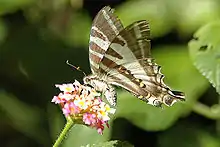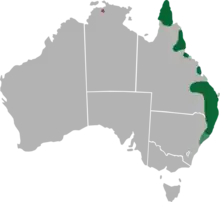Protographium leosthenes
Protographium leosthenes, the four-barred swordtail, is a medium-sized butterfly of the family Papilionidae found in Australia. It is similar to the five-barred (or chain) swordtail (Graphium aristeus) found in both Australia and India.[1]
| Protographium leosthenes | |
|---|---|
 | |
| Scientific classification | |
| Domain: | Eukaryota |
| Kingdom: | Animalia |
| Phylum: | Arthropoda |
| Class: | Insecta |
| Order: | Lepidoptera |
| Family: | Papilionidae |
| Genus: | Protographium |
| Species: | P. leosthenes |
| Binomial name | |
| Protographium leosthenes Doubleday, 1846 | |
 | |
| Range of four-barred swordtail P. l. leosthenes; P. l. geimbia | |
| Synonyms | |
| |
Appearance
Adults are brown and white, with four brown parallel bars running down the leading edge of the forewing. The hindwings have a pointed tail. Their wingspan is approximately 49 mm for males and 53 mm for females.[2][3] The four-barred swordtail can be distinguished from the five-barred swordtail by the number of bars, and pale orange and blue spots on the upperside of the hindwing. In addition, the four-barred swordtail has pale orange markings on the underside of its hindwing, rather than red markings.[3]
Biology
The eggs are cream coloured and laid singly on young leaves of the larval plant.[4] The larvae feed on Melodorum leichhardtii, Melodorum rupestre, Polyalthia nitidissima and occasionally Desmos wardianus.[3][4] Early instars are pale green, with black spots and a black thorax and tail. The caterpillar later becomes green with brown or yellow spots, and reaches a length of up to 3.5 centimetres.[4] The pupa is about 2 centimetres in length, and green with pink markings.[4] There is usually one generation per year, with adult emergence varying with the season.[3]
The preferred habitat is monsoon forest and subtropical rainforest, where the larval plants are found.[3] Adults fly near the ground (within about 2 metres) with their wings spread.[3] The males frequently hilltop.
Subspecies
- P. l. leosthenes (south-eastern coast of New South Wales and the Murray-Darling basin, northern Gulf and north-eastern coast of Queensland)
- P. l. geimbia (Tindale, 1927) (northern coast of the Northern Territory)
References
- "2. Protographium leosthenes (Doubleday)". Australian Insect Common Names. Commonwealth Scientific and Industrial Research Organisation (CSIRO, Australia). 19 September 2004. Retrieved 20 September 2008.
- "Four-barred Swordtail (Protographium leosthenes)". Oz Animals. Retrieved 22 June 2016.
- Braby, Michael (2004). The Complete Field Guide to Butterflies of Australia. Collingwood, Victoria: CSIRO Publishing. pp. 114. ISBN 9780643090279.
- "Protographium leosthenes". Australian Caterpillars and their Butterflies and Moths. 2015. Archived from the original on 17 May 2016. Retrieved 22 June 2016.
- Lepidoptera and some other life forms, Protographium
Further reading
- Edwin Möhn, 2002 Schmetterlinge der Erde, Butterflies of the World Part XIIII (14), Papilionidae VIII: Baronia, Euryades, Protographium, Neographium, Eurytides. Edited by Erich Bauer and Thomas Frankenbach Keltern: Goecke & Evers; Canterbury: Hillside Books. ISBN 978-3-931374-87-7 All species and subspecies are included, also most of the forms. Several females are shown the first time in colour.